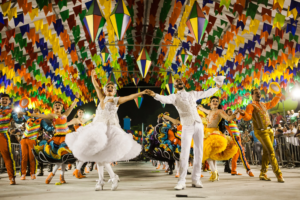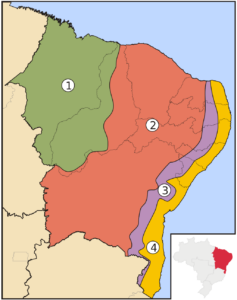Top 10 Must-Know Portuguese Terms for Forró Enthusiasts
Forró Federation, in collaboration with teacher Danilo Buckentin (@danilobuckentin), has curated a list of 10 essential Portuguese words for deepening your connection to Forró Dance. These words aren’t just words; they’re the soul of the dance, intricately part of its culture and history.
For newcomers to Forró, the enchanting dance moves and rhythmic melodies may immediately captivate, forming an instant bond. However, behind the sound of Zabumba, Triângulo and Sanfona, the traditional trio instrument in Forró, the essence of this music style is embedded in the lyrics and may not be comprehensible to non-Portuguese speakers.

Design: Claudia Ciniglio
Whether it’s something heard in songs or at events, some meanings are commonly difficult to translate into English or other languages because the background use of the word was developed regionally in the northwestern area of Brazil. However, once you understand what lies behind them, the bond to Forró becomes even stronger.
In light of this, we’re excited to introduce you to some of the essential words in the Forró lexicon. We invite you to share your own favorite words or recall your initial encounter with Portuguese within the Forró community.
To enhance your linguistic journey, we’ve curated a special playlist by Danilo Buckentin, allowing you to practice these words while immersing yourself in the melodic rhythms of Forró. Let the music guide you as you explore the captivating world of Forró, one word at a time. 🎶
Read the list while listening to words in some of our favorite songs:
10 Words to learn if you love Forró
-
CAFUNÉ
“Cafuné” is a Brazilian Portuguese term that refers to the act of gently running one’s fingers through someone else’s hair, typically soothingly or affectionately. It’s a gesture of intimacy and tenderness often associated with expressing love, care, and affection towards a partner, family member, or friend.
The word “cafuné” is derived from the Tupi-Guarani language and is widely used in Brazilian culture to describe this comforting and nurturing action. You’ll probably recognize it in the song “Te faço um cafuné” by Mariana Aydar.
-
CHAMEGO
Chamego refers to a tender or affectionate gesture, often in the context of deep relationships. It encompasses acts of physical closeness, such as cuddling, hugging, or holding hands, as well as verbal expressions of affection, like sweet words or compliments. It can also imply closeness, intimacy, or a comforting presence. Chamego is deeply rooted in Brazilian culture, particularly in the northeastern region, where it is often associated with warmth, hospitality, and emotional expressiveness. It reflects the Brazilian tradition of valuing close interpersonal relationships and fostering bonds of affection within families, friendships, and romantic partnerships. You can find it in songs like “Xamego”, by Luiz Gonzaga.
-
ARRAIAL

Festa Junina in Caruaru (Pernambuco, Brazil) Photo: Janine Moraes-MinC
Arraial (also appears as Arraiá) is a term used in Brazil to describe a traditional festivity, particularly associated with the June Festivals (Festas Juninas). These festivals often include dances, Forró as traditional music, typical food, and decorations.
When you go to such a party, you’re going to an “arraial” or it could also be called “Festa de São João”. You can find it in songs such as “Tei Tei no Arraiá” by Luiz Gonzaga.
-
PISTA
Pista or pista de dança translates to “dance floor”. It refers to the area designated for dancing at a party, club, or event. You may have heard it in songs like “Festa no Interior” by Gal Costa.
-
FOLE
Fole is equivalent to “bellows” in English. It refers to a device used to produce a concentrated blast of air, typically made of leather or similar material and used in various contexts such as blacksmithing, traditional musical instruments like the accordion (Sanfona), or even in certain types of cooking. For us, it’s the part that, as compressed or released, produces the Sanfona’s sound. Very famously mentioned in the song “O Fole Roncou” by Luiz Gonzaga, which means “the bellows snored” like it’s speaking louder or just making music.
-
QUADRILHA
Quadrilha is a traditional Brazilian folk dance that is especially popular during our already mentioned “Festas Juninas”. It typically involves a choreographed performance by a group of dancers, often telling a story or depicting rural life, and it’s accompanied by lively music. Brazilians are usually taught the steps when we’re kids at school.
You might have seen a quadrilha happening at a Forró party when some “arrastapé” song is playing. Two traditional songs for a Quadrilha are “Isso aqui tá bom demais” by Dominguinhos and “Olha pro céu” by Luiz Gonzaga, in both of them, the authors describe the festive moment.
-
PÉ DE SERRA
Pé de Serra translates literally to “mountain foot”. In the time of Seu Januário (Gonzaga’s father), there were many festivals in Araripe, which is a mountainous region. Hence the expression “Forró no Pé da Serra”.
The expression was used by Luiz Gonzaga to refer to his childhood and youth in the city of Exu in Pernambuco hinterland, at the “foot” of the Serra do Araripe, and also referred to the songs related to forró from that place. It can be found in songs like “Chamego”, “Pé de Serra”, from 1942, the Xote “No meu pé de serra” from 1946, and the arrasta-pé “Alegria de Pé”, from 1978.
Because of the emergence of the electronic forró music movement in the 1990s, the term “Forró Pé de Serra” came into widespread use to differentiate the recent movement from the previous more traditional one.
-
SERTÃO

Brazilian Northeast Subregions – 1: Meio norte, 2: Sertão, 3: Agreste, 4: Zona da Mata. Photo: Public Domain
Sertão (red on the map) refers to the Brazilian hinterland, particularly the arid and semi-arid regions of the Northeast. It’s a landscape characterized by drought, harsh conditions, and a unique culture. It is known for its rugged terrain, with rocky plateaus, dry riverbeds, and thorny vegetation, making agriculture challenging. It also served as a refuge for indigenous peoples, runaway slaves, and marginalized groups seeking autonomy and freedom from colonial rule.
In music, Sertão serves as a source of inspiration for various genres, including our Forró and other traditional Brazilian music styles, reflecting the region’s folklore, struggles, and resilience. You can find this word in songs like “Forró no Sertão” by Dominguinhos.
-
MANDACARU
Mandacaru is a type of cactus native to Brazil, commonly found in the northeastern region, especially in the Sertão. It’s often used metaphorically in songs to represent the arid landscapes and resilience of the northeastern people.
You may have heard it in songs like “O Xote das Meninas” by Luiz Caldas, (which is ironically classified as a Baião, not a Xote), where he sings “Mandacaru, quando fulora na seca, é o sinal que a chuva chega no Sertão.” That could be translated to: “Mandacaru, when it blooms during the drought, it’s the sign that rain is coming to Sertão.”
-
CANGAÇO

Lampião and his companions with cinematographer Benjamin Abrahão Botto. Photo: Public Domain
Cangaço was a social phenomenon in northeastern Brazil during the late 19th and early 20th centuries, characterized by the activities of bands of outlaws known as Cangaceiros, who roamed the rural hinterlands, engaging in acts of banditry, violence, and social rebellion. Factors such as poverty, land disputes, unequal distribution of wealth, and a lack of effective governance contributed to the rise of banditry as a means of survival and resistance among marginalized groups.
Cangaceiros (as seen in the picture) were considered criminals, but they also operated as a form of social justice, often targeting oppressive landlords, corrupt authorities, and exploitative intermediaries who exploited the rural population. These people adopted distinctive attire, including leather clothing, wide-brimmed hats, and ammunition belts, which became symbolic of their identity and defiance against social norms but also contributed to the aesthetic we have in Forró. You may have heard the story of the most famous couple of the Cangaço: Lampião and Maria Bonita, whose story was poetically told in “História de Lampião” by Jackson do Pandeiro.
________________
Please share our content with your Forró Community who would also like to learn more about the background in Forró History and Influences.
In case you want to dive into the Portuguese Language, the Forró Federation offers opportunities for language classes in the Forró context. Our first session started in March, and we will soon let you know when new groups are available.
If you have any questions or want more details or advice from the Forró Federation, write to forrofederation@gmail.com and we will try to help.
Follow us on Instagram, check the updates on Facebook and sign up for our ForróLetters.
